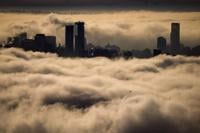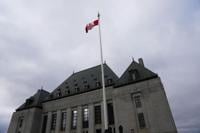Multiple social media posts about a “strange” fog affecting parts of the southeastern United States and Canada spread online after dense-fog advisories in those areas at the end of December. Users reported the fog looked strange compared with “normal” fog, had a strange smell or caused illness and difficulty breathing, with some users concluding the phenomenon was man-made. Claims the fog was man-made lack evidence and are misleading. Climate and meteorology experts say fog is an observable weather phenomenon that is not man-made, and there are plausible meteorological explanations for why fog might smell strange or have possible health impacts.
Fog blanketed parts of the southeastern United States and Canada in late December, with some areas issuing dense-fog advisories.
On Dec. 30 an X, formerly Twitter, user posted a of a foggy street with the overlaid caption, "Weird fogs in Toronto and the USA, it smells weird," with more than 16,000 likes and 7,000 shares.
Some commenters agreed the fog smelled strange and speculated it made them ill or caused difficulty breathing.
On TikTok, a Dec. 31 with more than 700,000 plays and 12,000 likes claimed to show a compilation of the “strange thick fog” from around the world.
The fog's similarity to snowflurries when viewed under light caused concern among some commenters about the health impacts of breathing in its “particles.”
Another X user questioned why the fog advisory for Ottawa was associated with higher pollutants in the air, as shown by an air quality index, and suggested someone might be “spraying the skies," in a .
Rating: Lacks evidence/misleading
While many social media users speculated about the cause of the fog, ���ϳԹ��� could find no evidence the weather seen at the end of December in Canada was in any way artificial.
���ϳԹ��� spoke to meteorologist Trudy Kidd and Dr. Chip Konrad, a professor at the University of North Carolina at Chapel Hill and the director of the .
Both experts say the recent fog is an observable weather phenomenon and there is a plausible meteorological reason that could explain the reported strange smells and health symptoms.
Fog smell and health impacts are explainable, experts say
Environment Canada said its weather records show fog at Ottawa International Airport from the morning of to the morning of .
The weather service issued a fog advisory for parts of southern Ontario on Dec. 29, including Ottawa and Toronto.
Kidd said the fog in Ottawa formed because a cold air mass moved in under a high pressure system.
This caused a weather phenomenon known as inversion, which happens when a layer of warm air remains over cold air.
“It acts like a lid on the air close to the ground and it traps any humidity as well as pollutants. It just makes the air pretty stagnant,” Kidd said, adding that inversion might be a possible reason some people smell something strange in the fog.
Kidd said a potential source of the smell in Ottawa in particular could be wood-burning stoves, whose smoke might linger in the air and smell stronger because of inversion.
She added that smoke from the stoves and other pollutants possibly contributed to the decrease in air quality on Dec. 28 and 29, around the time of the fog advisory in Ottawa.
Environment Canada provides its air quality forecasts by tracking predicted concentrations of ozone and fine particulate matter, or PM2.5.
Health Canada says PM2.5 are particles in the air that contain pollutants like smoke or soot, which may cause some people to experience such as trouble breathing or eye irritation, and aggravate existing lung and heart conditions like asthma and heart disease.
Konrad said inversion was a plausible explanation for the reportedly strange-smelling fog in the United States, adding that pollutants from paper mills along the coast and air conditions present during the fog could contribute to a stronger smell.
No evidence of abnormal or man-made fog
Konrad said multiple areas along the southeastern coast in the United States experienced advection fog, which forms when warmer air moves over a colder surface.
Cooler nighttime temperatures means air has less ability to hold water vapour, so the vapour undergoes condensation and forms tiny water particles, Konrad said.
"When you're looking at fog, you're looking at all those microscopic particles," he said.
Konrad said shining light into dense fog will reveal the particles, or droplets, that collectively make up fog.
Past filmed before the December fog advisories show these fog droplets are visible when looking at fog under light.
"Fog is common and we see it," he said.
Some cities in the United States did experience more foggy days than is typical for the season.
For example, the ���ϳԹ��� Weather Service Twin Cities, Minn. had its "most persistent fog since 1997" on Dec. 30.
However, there is no evidence to suggest the fog was man-made.
"In the southeast in the winter when you get wind blowing on shore and you have clear skies, it's very common. Fog can be very dense … fog is a natural phenomenon," Konrad said.
Sources
Claim about the fog causing illness spread on X on Dec. 30, 2024 (,
with fog smell claim from Dec. 29, 2024 ()
X about fog advisory in Ottawa from Dec. 30, 2024 ()
TikTok of fog videos from Dec. 31, 2024 ()
()
Environment and natural resources hourly weather data report for Ottawa on (), () and ()
()
()
– Julian Ilett, YouTube, Jan. 4, 2015 ()
from NWS Twin Cities on Dec. 30, 2024 ()
About ���ϳԹ��� Press fact checks
You can find out more about ���ϳԹ��� here and about ���ϳԹ��� Press Fact Checks here. To reach our fact-checking team with any tips, corrections or comments, please email us at cpfactcheck@thecanadianpress.com.






































